The elders: Indigenous photography in Australia
Gael Newton
This essay originally published in the catalogue
for the
2006 NGA exhibition
Michael Riley Sites Unseen
The first contemporary art exhibition of work exclusively by Aboriginal and Torres Strait Islander photographers took place in Sydney in September 1986 as part of NADOC '86, a week-long event celebrating the history, culture and achievements of Australia's Indigenous people.1
Titled NADOC '86 Exhibition of Aboriginal and Islander photographers, the exhibition was held at the Aboriginal Artists Gallery in Clarence Street, Sydney and included some 60 photographs by Mervyn Bishop, Brenda L Croft, Tony Davis, Ellen Jose, Darren Kemp, Tracey Moffatt, Michael Riley, Christopher Robinson, Ros Sultan, and Terry Shewring.2
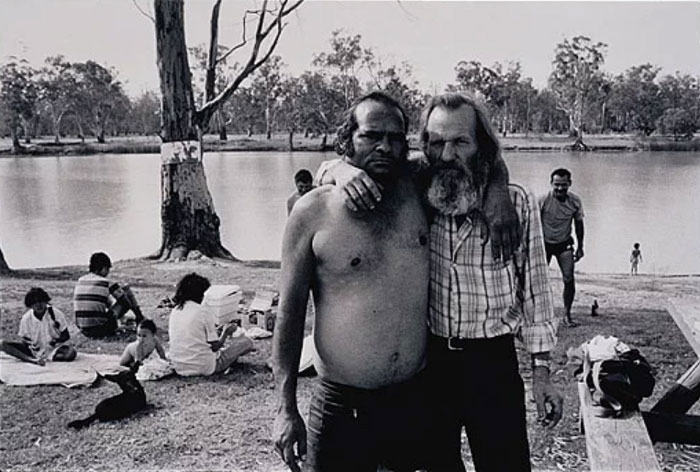 |
Michael Riley: Mark Morgan and Edward Urquhart on the bank of the Murray River, Robinvale 1986
( CollectionNational Gallery of Australia, Canberra) |
All were influenced by the general excitement in these years about photography as a youthful contemporary artform; one also seen as an accessible and immediately responsive form of witness. As well, these years saw a resurgence of 'the personal is political'activism and liberalism of the 1960s-70s.
The embrace in the 1970s of marginalised and diverse cultures also intersected with the pluralism of post-modernism in the 1980s, encouraging borrowings of past imagery and cross-referencing between mediums.
The 1980s were marked by unprecedented consumer affluence for some and protests from others who were excluded or less inclined to accept the status quo. The Brixton race riots in England in 1981 were seen and consumed worldwide through the media, with still photography revealing the power of direct action.
In Australia, the effects of a previous decade of government support for more inclusive models of cultural practice had benefits. There was a heightened awareness of Indigenous cultures and communities across Australia in cities, country towns and remote out-stations, largely the result of active campaigning by Indigenous people.3
In the cities, protests were mounted about Aboriginal deaths in custody but debates also raged around the very definition of Aboriginality'.4
The latter term was diversified beyond anthropological and bureaucratic straitjackets, affirming the legitimacy and role of urban-based Indigenous people. 'Koori', for example, became popular as a term for urban Indigenous people in the south-east of Australia.
The 1988 Bicentenary of the European settlement of Australia was also a catalyst for reconciliation efforts and recognition of Indigenous rights, achievements and new creative endeavours. It provided the impetus, as well, for curatorial projects such as the Australian Institute of Aboriginal and Torres Strait Islander Studies photography commission, After 200 years.
This massive undertaking documenting Aboriginal Australia commenced in 1985 and aimed for real community engagement. Participating photographers engaged with Aboriginal communities through strict protocols. Of the 21 photographers assigned to the project, only Kathy Fisher, Alana Harris, Ricky Maynard, Polly Sumner, Tess Napaljarri Ross, Helen Napurrula Morton, Peter McKenzie and Riley were Indigenous.5
Aboriginal poet, activist and photographer Kevin Gilbert, however, mounted a touring photography exhibition called Inside Black Australia in protest against the Bicentenary celebrations.
Throughout the 1970s and 1980s, photomedia were acquiring a higher profile in the'fine arts'. Art schools were increasingly amalgamated with universities - and from 1972, under a free tertiary education scheme, they were energised by a more varied student body.
Of the exhibitors in the NADOC '86 show, Moffatt and Jose were art-school graduates and Riley had recently become an assistant in the photography department at the Sydney College of the Arts.
Mervyn Bishop was the only well-established professional photographer among the NADOC '86 Indigenous photographers group. Born in Brewarrina, New South Wales in 1945, he had worked as a photojoumalist since the 1960s for The Sydney Morning Herald and between 1974 and 1979, he was a photographer at the newly established Department of Aboriginal Affairs.
Photographs at the opening of the NADOC '86 exhibition taken by William Yang, a documentary photographer of Chinese heritage, show some of the exhibitors at what became an historic occasion. The brick walls were not so classy but the event was an art opening with the requisite hip and stylish attendees.
While not the product of a tight preexisting 'group' or movement per se, the NADOC '86 exhibition was strategic and savvy, successfully positioning the work in the art gallery scene. Wider issues, the focus of all works, were embodied in a series of individually differentiated, deft, sophisticated or stylish manners.
Each exhibitor subtly undermined the deadweight legacy of ethnographic documents and negative media stereotypes.
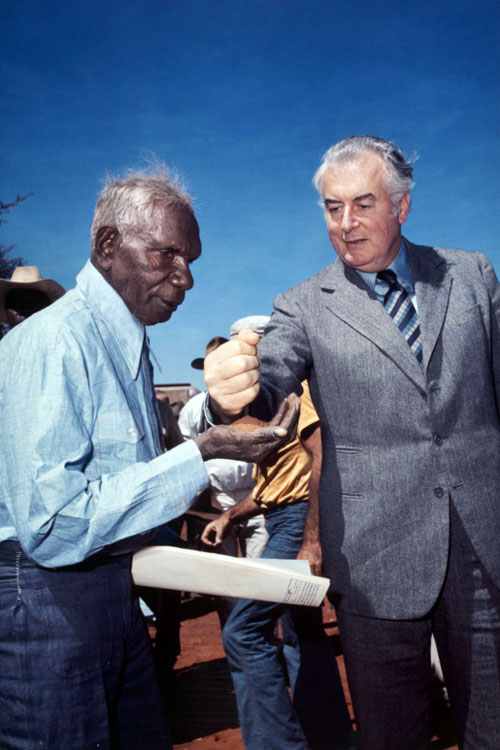 |
Mervyn Bishop: Prime Minister Gough Whitlam pours soil into hand of traditional landowner Vincent Lingiari,
Northern Territory 1975.
Collection - National Gallery of Australia, Canberra |
Mervyn Bishop exhibited his iconic 1975 photograph of Labor Party Prime Minister, the Hon. Gough Whitlam MP, pouring soil into the hand of Gurindji elder Vincent Lingiari, symbolising the return of land rights to the Gurindji people in the Northern Territory.
But in 1986 Bishop, too, was on a new journey as bold as that of his younger associates. He had left his job with the Department of Aboriginal Affairs, turned freelance, undertaken further study, and begun teaching at Tranby Aboriginal College in Sydney.
Bishop is often described as the first high-profile Indigenous photographer in Australia, but a number of Aboriginal people, including his own mother, had actively taken photographs since the early twentieth century or had a personal practice of compiling albums and having pictures taken.
The 1986 show was preceded by the pioneering showof Indigenous artists, mainlyfrom urban communities, called Koorie art '84. This show included the work of several photographers, notably Riley, Shewring and Ian Craigie.
The NADOC '86 artists could not begin from a tabula rasa in quite the same way that an earlier generation of photographers in the 1970s could imagine themselves taking up a 'new' medium.
For these earlier artists, photography seemed 'new', uninfected - the medium had no baggage of history, or so they thought. For this new generation of highly directed Indigenous artist-photographers to begin meant, inevitably, that first there would be some back-tracking, including references to the history of race relations and earlier photography of Indigenous people.
The NADOC '86 show marked the beginning of a public profile within the art world for contemporary Indigenous photographers.6
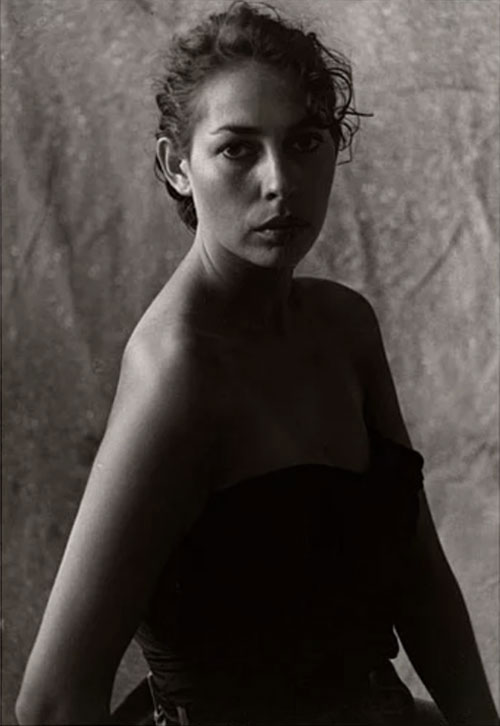 |
Michael Riley: Telphia from Portraits by a window 1990
Collection - National Gallery of Australia, Canberra |
| |
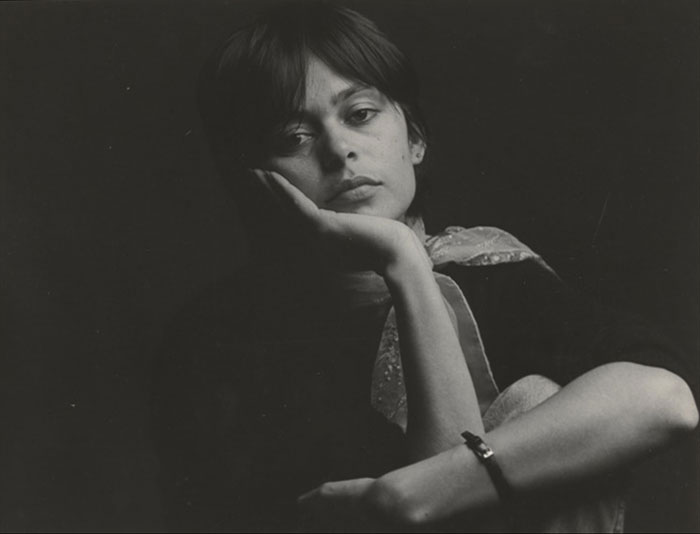 |
Michael Riley: Avril 1986 (Avril Quaill)
Collection - National Gallery of Australia, Canberra |
The invitation to the exhibition used Michael Riley's moody, Hollywood-style portrait of Kristina Nehm, a student at the Aboriginal and Islander Dance Theatre. Her pose recalled old stereotypes of dusky', black beauties languidly acquiescing to the camera's caress yet, as Anthony'Ace'Bourke, then Director of the Aboriginal Artists Gallery and co-ordinator of the show, recalls, the picture 'was very political, black girls weren't meant to be seriously chic'.7
Kristina is both revealed by the camera's focus on her but also eludes exposure behind her fashionable sunglasses. Yet no magazine then would have hired her.
The works on display in the NADOC '86 show ranged from reportage to manipulated images, some with a sharp political edge. Others were remarkable for their lack of bombast.
Moffatt's work attracted the only press coverage. Her black-and-white series, Some lads, showed dancers from the Aboriginal and Islander Dance Theatre quite nonchalantly, cheekily, passionately playing and posing - anything but the sobriety or anonymity of photographs of corroborees or even classical dancers. Her colour image of dancer and actor David Gulpilil mimicked the sun-baking, beer-drinking Aussies at Bondi Beach.
Like Riley's Kristina, which claimed a right to be glamorous, Moffatt's images were tuned to the issues of naming rights, identity and dress - an agenda that would be a leitmotiv for many Indigenous photographic artists.
Identity, it seems, would be dependent on inserting the unfamiliar dark face in the white scene. Moffatt and Riley grounded their works in the issues of dress and undress which are central to how the 'native' is seen (and not seen).
These issues are present in the viewing of photographs of and by Indigenous people. References to self-presentation are also central to the work of Brenda L Croft and Fiona Foley, both sophisticated artists in several media.
Moffatt's images in the 1986 show were staged but believable fictions. It could be argued that the post-modernism in the contemporary art of the 1980s - with its faith in appropriation and disruption of the notion of an original pure canon, centre or method -greatly favoured the work of those formerly excluded from power and presence: women and ethnic'others' of all kinds.
It allowed for a running commentary on the past and was most effective when tied to a social rather than purely aesthetic agenda.
Moffatt has gained considerable international acclaim for her work. Her politics have included the refusal to be categorised as an Aboriginal, a woman and a photographer, suspecting as she did with the NADOC '86 show that attention came from tokenism, not engagement with the work or its normalising within contemporary art.8
A year after the Bicentenary, Mervyn Bishop posed an enigmatic question in a self-portrait called Is there an Aboriginal photography? But over the next decade or so, many Indigenous photographers - including Croft, Bishop, Moffatt, Riley and Jose - would all go on to diverse roles as photomedia artists and leaders of the Indigenous arts revolution, widely recognised both nationally and internationally.
Other shows by Indigenous photographers followed in the next five years, aided by the establishment of dedicated venues such as Boomalli Aboriginal Artists Co-operative in 1987, by the national tour of Gilbert's Inside Black Australia, and also by the incorporation of Indigenous artists in standard dealer-gallery representation systems.
A new generation of Indigenous photo-based artists and curators also appeared. Destiny Deacon, for example, a Kuku-Erub/Mer woman based in Melbourne, began exhibiting in 1990.
Appending the term Blak to her titles, and employing a kind of Creole satirical language throughout her works, she is now among the best-known Indigenous artists from Australia on the international scene.
A number of Indigenous Australian photomedia artists came to international prominence in the 1990s. Arguably, they had higher profiles in the United Kingdom and the United States of America than Indigenous artists from other lands, and they achieved comparable levels of success to ethnic'artists of colour'within those countries.
As in Australia, the United States experienced a surge in the development of young Native American photomedia artists during the mid-1980s and early 1990s.9
In part, this was in response to the teaching of photography in art schools and the establishment of dedicated, often government supported, art galleries which, like Boomalli in Australia, provided venues for the exhibition of Native American art.
But the quincentennial 'celebrations' in 1992 of the discovery of the Americas by Columbus also proved to be a catalyst as people realised photography was the perfect medium to illustrate and confront issues arising from colonisation by Europeans. Aperture, Views, Afterimage and other photo-journals all featured Indigenous photographers in that year, and some of the most courageous and intriguing shows of contemporary Native American work to date toured the United States and Canada.
Indigenous Australian artists, Riley amongst them, benefited from the increased, although still marginalised, interest.
In 1993, Michael Riley made a key work called Sacrifice. It was first shown in black and white at the Hogarth Galleries in Sydney, a dealer-gallery specialising in Aboriginal art and directed by Anthony'Ace' Bourke, the former Director of the Aboriginal Artists Gallery.
Sacrifice was an overtly symbolic and ambiguous series of shots of objects and bodies, constructing a complex allegory of sacrifice. Riley interposed a black male torso in place of Christ and turned spoons of the sacraments towards the heroin crisis.
Although his works would grow in scale, colour, fantasy and complexity, Riley's subsequent work would never lose the sense of elegy and personal displacement first revealed in this eloquent series.
Because of his art's location within an Indigenous politics, it is perhaps Riley's role as an artist to offer the open-ended lack of literality and proscription in his work as an opportunity for art to be open to interpretation and open to all. He was in many ways a traditional western and Indigenous artist, addressing the universal through the highly specific and local situation.
The majesty and ethereality of his last, large colour series has no barriers at the door for viewers not of colour; they allow for peace and redemption.
Offering this quality of topical metaphysics would seem to be Riley's particular role within his generation.
NOTES
- For a history of this event, which evolved from the 1920s and gathered increased profile during the 1970s - link here to Naidoc website. In 1988, the event became known as NAIDOC Week, reflecting the name change of the management committee to the National Aboriginal and Islander Day Observance Committee. Since 1992, NAIDOC events have been held in the first week of July.
- The Aboriginal Arts Board of the Australia Council funded the Aboriginal Artists Gallery in Clarence Street, Sydney. The Gallery's first director was Anthony' Ace' Bourke, later Director of the Hogarth Galleries, Australia's oldest established Aboriginal fine art gallery.The NADOC '86 exhibition was initiated by Brisbane-born Aboriginal photographer and filmmaker, Tracey Moffatt, following an invitation from Ace Bourke.
- Indigenous people were not counted on the census until 1967, although they had voting rights from the early twentieth century, which were not generally exercised. Native Americans in Canada received voting rights in 1960 and, in the United States of America, indigenous rights were clarified by the 1965 Voting Rights Act and subseguent amendments.
- The Royal Commission into Aboriginal Deaths in Custody was established in 1987.The Commission examined all deaths in custody in each State and Territory which occurred between 1 January 1980 and 31 May 1989, and the actions taken in respect of each death.
- Taylor, Penny (ed.), After 200 years: Photographic essays of Aboriginal and Islander Australia today, Canberra: Aboriginal Studies Press, 1988.
- See Moffatt, Tracey (ed.), In dreams: Mervyn Bishop - Thirty years of photography 1960-1990, exhibition catalogue, Sydney: Australian Centre for Photography, 1991. See also Lee, Gary/Picturing: Aboriginal social and political photography', Artiink vol.20, no. 1,2000.
- Anthony Ace'Bourke in conversation with the author, June 1997.
- Moffatt received considerable criticism for her stance.
- This discussion is drawn from email correspondence between the author and Veronica Passalqua, Curator, C.N. Gorman Museum, University of California Davis, 19 February 2006. The museum was founded in 1973 by the Department of Native American Studies. See also Carl Nelson Gorman Museum website.
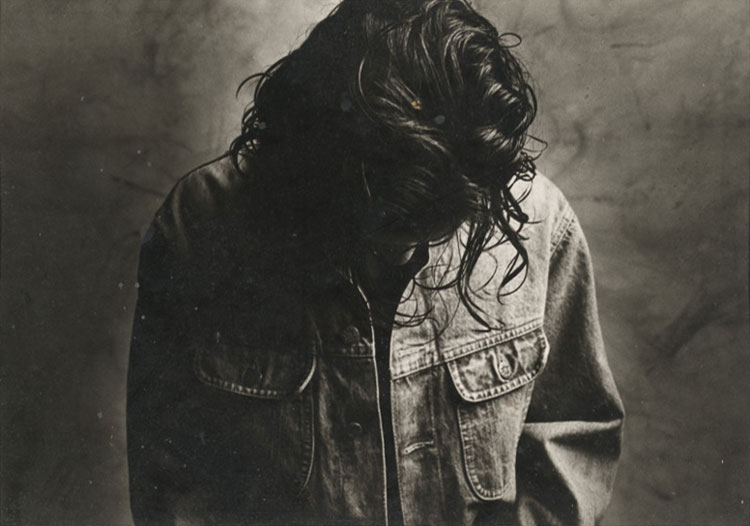 |
Tracey [head down] 1986
Collection - National Gallery of Australia, Canberra |
| |
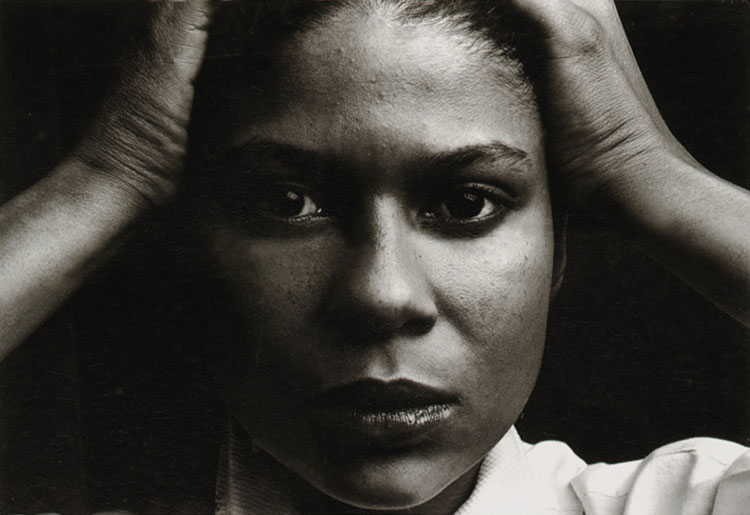 |
Krishna [no glasses] 1984
Australian Institute of Aboriginal and Torres Strait Islander Studies |
Gael Newton AMwas Senior Curator of Photography at the National Gallery of Australia, Canberra, and author of a number of reference works, exhibition catalogues and monographs on the history of photography.
In the early 1990s, using the KODAK Australasia Pty Ltd Fund for emerging photographers, she began a special focus collection of contemporary Indigenous photographers for the National Gallery of Australia permanent collection, recognising the significance of the emergence of Indigenous urban photographers in the mid-to-late 1980s.
>>> MORE on Michael Riley
Gael Newton's Essays and Articles
|